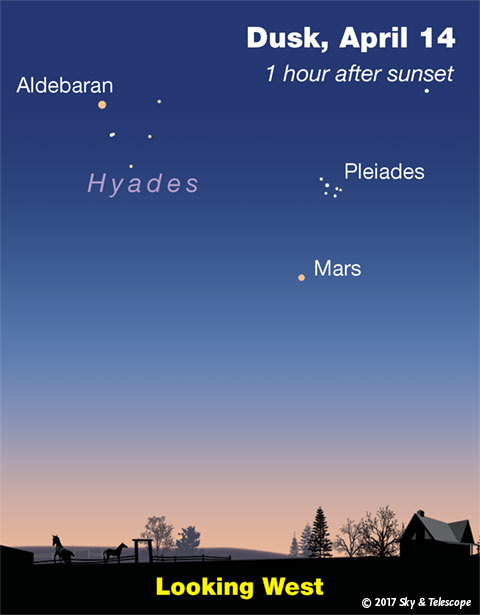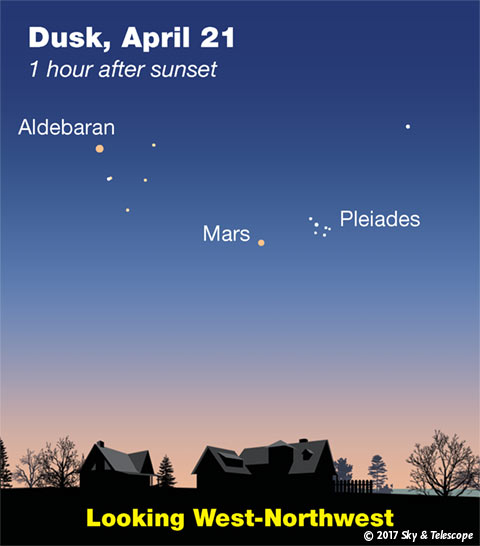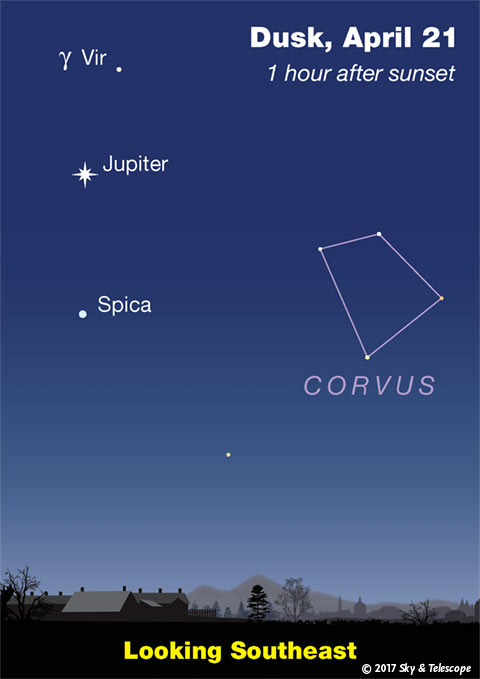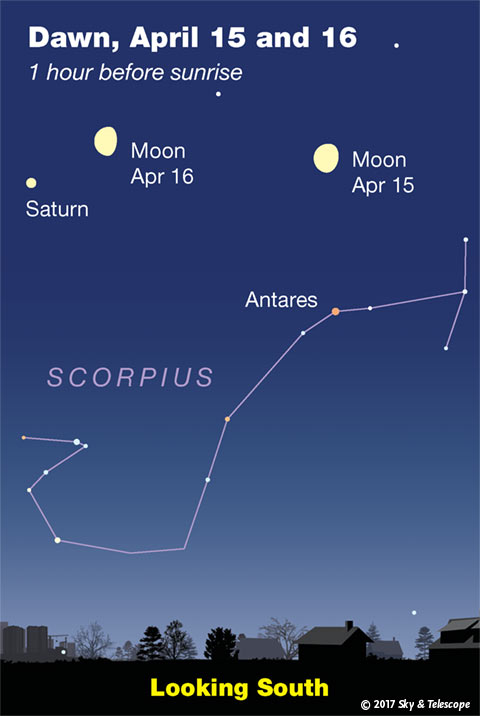Three comets are still in range of good binoculars. Comets 41P/Tuttle-Giacobini-Kresak, C/2017 E4 Lovejoy, and C/2015 ER61 PanSTARRS are all glowing at about 6th or 7th magnitude (though PanSTARRS now seems to be fading). See Comet PanSTARRS in Outburst and Binocular Bright. (For Comet 41P, use the chart here; the one in the May Sky & Telescope is somewhat off.)


Friday, April 14
• Arcturus shines brightly in the east these evenings, well to the left or upper left of even brighter Jupiter (by about three fists at arm's length). Arcturus forms the pointy end of a long, narrow kite asterism formed by the brightest stars of Bootes, the Cowherd. The kite is currently lying on its side to Arcturus's left. The head of the kite, at the far left, is bent slightly upward. The kite is 23° long: about two fists at arm's length.
Saturday, April 15
• Before and during early dawn Sunday morning, look for Saturn below or lower left of the waning gibbous Moon.
Sunday, April 16
• Jupiter's Moon Europa crosses the planet's face tonight from 10:05 p.m. to 12:28 a.m. EDT, followed by its tiny black shadow (much more easily visible) from 10:29 p.m. to 12:57 a.m. EDT. Then Jupiter's Great Red Spot crosses the planet's central meridian around 1:18 a.m. EDT.
Monday, April 17
• Bright Arcturus is climbing high in the east these evenings. Equally bright Capella is descending high in the northwest. They stand at exactly the same height above your horizon at some moment between about 9:00 and 10:30 p.m. daylight-saving time, depending mostly on how far east or west you live in your time zone. Can you time this event? Like everything star-related, it happens 4 minutes earlier every night.
Tuesday, April 18
• As twilight fades away, modest Mars glows less than 4° from the Pleiades from now through Sunday.
Wednesday, April 19
• Right after dark, the Sickle of Leo stands vertical high due south. Its bottom star is Regulus, Leo's brightest. Leo himself is walking horizontally westward, with the Sickle forming his front leg, chest, mane, and part of his head.
• Last-quarter Moon (exact at 5:57 a.m. EDT this morning.)
Thursday, April 20
• This is the time of year when, as the last of twilight fades away, the bowl of the dim Little Dipper extends straight to the right of Polaris. High above the end-stars of the Little Dipper's bowl, you'll find the end-stars of the Big Dipper's bowl.
Friday, April 21
• As night descends, look high in the west for Pollux and Castor lined up almost horizontally (depending on your latitude). These two stars, the heads of the Gemini twins, form the top of the enormous Arch of Spring. To their lower left is Procyon, the left end of the Arch. Farther to their lower right is the other end, formed by Menkalinan (Beta Aurigae) and then brilliant Capella. The whole thing sinks in the west through the evening.

• The weak Lyrid meteor shower should peak in the hours before Saturday's dawn. The Moon will be only a waning crescent. The shower's peak usually lasts just a few hours, but this year the predicted timing (12h Universal Time April 22) is good for North America, especially the West.
Saturday, April 22
• The spring constellation Corvus, the Crow, perches in the southeast these evenings, about a fist and a half at arm's length to the right of Spica as shown here. But above Spica this year is brilliant Jupiter, hogging the show. Corvus is traditionally seen as ready to snatch sparkling Spica out of Virgo's hand. This year he has a brighter shiny to go for.
________________________
Want to become a better astronomer? Learn your way around the constellations! They're the key to locating everything fainter and deeper to hunt with binoculars or a telescope.
This is an outdoor nature hobby. For an easy-to-use constellation guide covering the whole evening sky, use the big monthly map in the center of each issue of Sky & Telescope, the essential guide to astronomy.

Once you get a telescope, to put it to good use you'll need a detailed, large-scale sky atlas (set of charts). The basic standard is the Pocket Sky Atlas (in either the original or Jumbo Edition), which shows stars to magnitude 7.6.
Next up is the larger and deeper Sky Atlas 2000.0, plotting stars to magnitude 8.5; nearly three times as many. The next up, once you know your way around, is the even larger Uranometria 2000.0 (stars to magnitude 9.75). And read how to use sky charts with a telescope.
You'll also want a good deep-sky guidebook, such as Sue French's Deep-Sky Wonders collection (which includes its own charts), Sky Atlas 2000.0 Companion by Strong and Sinnott, or the bigger Night Sky Observer's Guide by Kepple and Sanner.
Can a computerized telescope replace charts? Not for beginners, I don't think, and not on mounts and tripods that are less than top-quality mechanically (meaning heavy and expensive). And as Terence Dickinson and Alan Dyer say in their Backyard Astronomer's Guide, "A full appreciation of the universe cannot come without developing the skills to find things in the sky and understanding how the sky works. This knowledge comes only by spending time under the stars with star maps in hand."
This Week's Planet Roundup
Planetary imager Damian Peach assembled this smoothed movie of Jupiter from images he shot February 25–28, using the 1-meter Chilescope remotely.

Mercury is out of sight in the glare of the Sun.
Venus (magnitude –4.7) shines low in the east as dawn brightens. It's a thin crescent in a telescope, thickening a little every morning.
Mars (magnitude +1.5, in Taurus) glows in the west in late twilight to the lower left of Aldebaran — which is similarly colored and slightly brighter. Look for the sinking Pleiades above Mars early in the week, and to the right of Mars by week's end, as shown at the top of this page.
Jupiter (magnitude –2.5, in Virgo) shines in the east-southeast at dusk. It's highest in the south by around midnight daylight saving time. Spica hangs a good 8° below it now. In a telescope Jupiter is still 44 arcseconds across its equator, still essentially the same as at opposition April 7th.
Saturn (magnitude +0.3, in Sagittarius) rises around 1 a.m. and glows highest in the south by early dawn, upper right of the Sagittarius Teapot. Redder Antares (magnitude +1.0) twinkles 19° to Saturn's right in the early-morning hours.
Uranus is hidden behind the glare of the Sun.
Neptune is still too low for observing before dawn.
__________________________
All descriptions that relate to your horizon — including the words up, down, right, and left — are written for the world's mid-northern latitudes. Descriptions that also depend on longitude (mainly Moon positions) are for North America.
Eastern Daylight Time (EDT) is Universal Time (UT, UTC, or GMT) minus 4 hours.
__________________________
"This adventure is made possible by generations of searchers strictly adhering to a simple set of rules. Test ideas by experiments and observations. Build on those ideas that pass the test. Reject the ones that fail. Follow the evidence wherever it leads, and question everything. Accept these terms, and the cosmos is yours."
— Neil deGrasse Tyson, 2014
"Objective reality exists. Facts are often determinable. Vaccines stop diseases. Carbon dioxide warms the globe. Science and reason are no political conspiracy; they are how we discover reality. Civilization's survival depends on our ability, and willingness, to do so."
— Alan MacRobert, your Sky at a Glance editor
"Facts are stubborn things."
— John Adams, 1770
Stand against falsehoods, denialism, and suppression of research. March For Science on April 22nd, in Washington DC and 500-plus other cities and towns, to “champion publicly funded and publicly communicated science as a pillar of human freedom and prosperity.”
 1
1









Comments
GlynandRose
April 15, 2017 at 11:35 am
We read in our local news that the 2014-JO25 object will give earth close shave visit in the night sky on 19th April. This object will pass at three times the distance of the moon and will be very bright. Apparently it can be seen through a normal telescope along with the comet Pan-Starr. In which direction in the sky will we be able to see it, also will we be able to see it from Johannesburg in South Africa? Thanks and regards
You must be logged in to post a comment.
You must be logged in to post a comment.